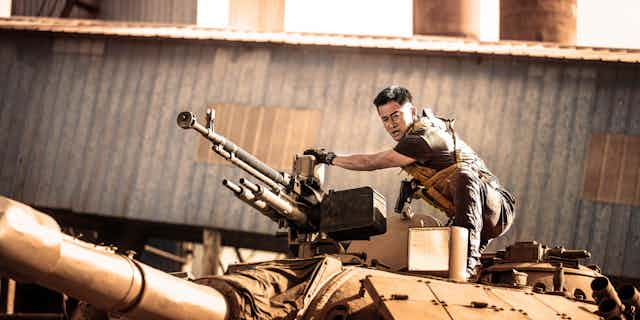The Chinese film Wolf Warrior II (2017) has been a runaway success – even though it contains controversial expressions of Chinese nationalism and racist stereotypes of Africans. It is one of the most commercially successful Chinese movies, having grossed over US$800 million at the Chinese box office. Only Star Wars: The Force Awakens has performed better at the box office in a single territory.
The film tells the story of an exiled elite Chinese soldier who travels to an unnamed African country on a personal matter. He gets caught in the middle of a civil war between government troops and mercenaries. The hero rescues African and Chinese civilians and defeats the mercenaries.
In a recent analysis, we argue that the movie does more than reproduce clichés from Hollywood action cinema. It is also an expression of how China sees its global status today, a status developed across its post-revolutionary and post-socialist periods from the mid 1970s.
Our study of the film identifies the historical precedents and ideological shifts within the nationalist discourse of “China in Africa”. We also provide contemporary contexts for the power dynamics between China and African nations.
A new discourse on China and Africa
The tide of westernisation sweeping China since the 1980s weakened its focus on African countries once considered allies. Media coverage of Africa dwindled in China. State media outlets such as Xinhua News Agency and the People’s Daily diminished their focus on Africa and the commercial ones found the continent “not attractive enough to make a huge investment”.
At the same time, the influx of western and Hollywood films filled the gap in the public perception of Africa. African countries, once portrayed as beacons of modernity, began to be shown as having poor, lagging economies. This is evident in the scenes of slums and the plots of war and plague in the fictional Africa in Wolf Warrior II.
Since 2010, China’s Africa engagement has entered a new phase. It is centred on the Belt and Road Initiative, which promotes infrastructure development in more than 150 countries in the world. The historical narrative of friendship between China and Africa has reappeared in mainstream national media in China. It’s getting renewed attention due to economic incentives in the form of the Forum on China-Africa Cooperation, a platform established by the Chinese government to strengthen its multilateral economic relations with African countries.
The caricatured representations of Africa in Wolf Warrior II comprise a patchwork of memories from different historical periods. From the 1950s to the 1970s, Africa was commonly represented in China as a close “third world” brother. The 1980s to the 2000s presented Africa as a poor stranger. Finally, in the 2010s Africa is a business partner of the Belt and Road Initiative.
China in Africa
These different narratives can sometimes overlap. The movie brings together a montage of elements like Somali pirates, Ebola, impoverished townships in South Africa, and the Libyan Civil War. This creates a pan-African stereotype that serves mainly to support China’s nationalistic imagination of the rise of the country as a global leader.
Similarly, elements of China-Africa relations from different historical periods are used to create a benevolent role for China in Africa. The film depicts friendship and aid, poverty-stricken Africa, and the leadership of China in the global south. Such depictions of a “generous” China cloud the unequal power relations embedded in the Belt and Road Initiative relationship.
In Wolf Warrior II, China is a beacon of hope, development and peace in Africa. A lead female character, for example, discovers the cure for a fatal disease. A Chinese owned factory provides jobs and asylum during scenes of conflict. In the film, the Chinese government exercises diplomatic generosity by accepting an official request for military assistance from the local government to fight the rebels.

This benevolence is presented in contrast to absentee American and bloodthirsty European mercenaries. As academics have observed, Wolf Warrior II appears to present “a new master race that has arrived to displace the whites as the new saviour of an ‘Africa’ ravaged by civil war, political chaos, starvation, and deadly disease”. As the representative of this “master race”, the lead character, Feng, becomes a messianic figure. Speaking about incarcerated Chinese and African workers, he claims, “I was born for them.” The film closes with Feng holding up the Chinese flag, leading survivors of conflict on a truck to a UN sanctuary.
Conclusion
It has been five years since the release of Wolf Warrior II. Yet the nationalism and racism seen in the film have not faded within China. Indeed they have grown stronger, especially on social media in China.
Against this backdrop, the “China in Africa” shown in Wolf Warrior II seems to fall back once again on the Third World Alliance of the Maoist era. But the regional inequality between China and African countries goes well beyond Cold War-era relations.
Rather, Wolf Warrior II dramatises emerging political and economic relations within the global south that are likely to generate new variations of the “China in Africa” narrative. These answer to a much more complicated political and economic role for China in the post-pandemic era that foresees a new divided world order.

